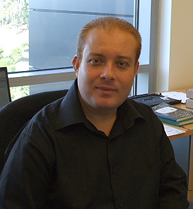Contact: Aditi Risbud (510)486-4861, [email protected]
Despite its tremendous potential as a limitless resource of energy, solar power is currently a small fraction of the global energy supply. Now, researchers at Berkeley Lab and Stanford University have developed a new method to characterize how a single photon can create multiple charge carriers—a phenomenon that could be used to develop more efficient solar cells.
The performance of photovoltaic devices is directly linked to the efficiency with which absorbed light from the sun, in the form of photons, is converted into electricity. Hampered by challenges in conversion efficiency and high cost relative to conventional power sources, solar power has yet to step into the limelight.
Traditional solar cells operate on the concept that one absorbed photon generates a single electron-hole pair, called an exciton, with excess energy dissipated as heat. In a bulk crystal, these electron-hole pairs become charge carriers—electricity—traveling over a finite distance.
In the nanoscale realm of semiconductor quantum dots, however, excitons are confined in all three dimensions. Scientists have previously discovered the proximity of one exciton to another make interactions between them more likely. Recently, researchers have been studying these interactions and the generation of multiple excitons from a single photon. Indeed, theory suggests if multiple excitons could be generated from a single photon with high energy, the efficiency of a solar cell could rise by 25 percent.
Molecular Foundry staff scientist Taleb Mokari and colleagues at Stanford University have devised a clever tactic to characterize this elusive property based on the absorption profile of lead selenide, a common semiconductor quantum dot material.
Mokari and colleagues’ method provides a straightforward way to interpret how many excitons a quantum dot can produce, despite the complex electronic structure of a quantum dot. This finding will help other researchers identify and study viable candidates for more efficient solar cells.
“Efficient multiple exciton generation observed in colloidal PbSe quantum dots with temporally and spectrally resolved intraband excitation,” by Minbiao Ji, Sungnam Park, Stephen T. Connor, Taleb Mokari, Yi Cui and Kelly J. Gaffney appears in Nano Letters online.
